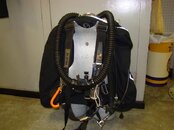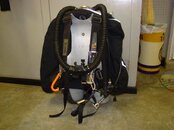Comparing a DA Aqua Master to a Royal Aqua Master (or a Phoenix Royal Aqua Master), I totally agree with what Nemrod already said. I will just add the following.
As mentioned the unbalanced diaphragm design will breath easier at the end of the dive than at the beginning. You are very familiar with the unbalanced piston, the diaphragm IP change is reversed and if I recall correctly it tends to change more than an unbalanced piston (like the MK-2).
Unbalanced regulators are designed with smaller volcano orifices in order to reduce the IP swing with the change in tank pressure. This means that in a high flow demand condition they will probably deliver the needed flow, but the IP will drop and will take longer to recover between breaths. In most relaxed diving situations the difference may be small, but there is a difference.
The larger orifice of a RAM does show a difference with the IP recovery from the normal IP dip during the inhaling cycle.
In the design of the latest Phoenix (Mod II, 2007 and newer) I enlarged and stream lined the air passages from the volcano orifice all the way to the port feeding the second stage. Due to the lack of precise instrumentation I can't fully confirm my findings, but from the limited testing and observations it seems to also perform better than I first expected.
The intermediate pressure recovery during inhalation is much quicker. In my primary Phoenix I have actually lowered the IP back to 135 psi (I normally used 145 to 155 psi) and it is performing as good as with the higher IP.
As Nemrod mentioned, a well tuned DA can be a very good performer and give a very good idea of how a double hose performs, but with a RAM you can really push the limits in performance.
With a RAM you a capable of tuning it so precisely that then you need the slits of the duckbill to be right in the center of the diaphragm or you will get small free flows when the exhaust is just higher than the diaphragm. A DA is seldom stable enough to push that kind of limit and then it will only happen with low tank pressure..
If you read some of the early evolution of the Phoenix, you will see that the addition of the ports was later. The original purpose was to make just RAM nozzle to be able to convert DA to RAM. Parts for the RAM will be around as long as Aqua Lung is around and the performance is the best.
As mentioned the unbalanced diaphragm design will breath easier at the end of the dive than at the beginning. You are very familiar with the unbalanced piston, the diaphragm IP change is reversed and if I recall correctly it tends to change more than an unbalanced piston (like the MK-2).
Unbalanced regulators are designed with smaller volcano orifices in order to reduce the IP swing with the change in tank pressure. This means that in a high flow demand condition they will probably deliver the needed flow, but the IP will drop and will take longer to recover between breaths. In most relaxed diving situations the difference may be small, but there is a difference.
The larger orifice of a RAM does show a difference with the IP recovery from the normal IP dip during the inhaling cycle.
In the design of the latest Phoenix (Mod II, 2007 and newer) I enlarged and stream lined the air passages from the volcano orifice all the way to the port feeding the second stage. Due to the lack of precise instrumentation I can't fully confirm my findings, but from the limited testing and observations it seems to also perform better than I first expected.
The intermediate pressure recovery during inhalation is much quicker. In my primary Phoenix I have actually lowered the IP back to 135 psi (I normally used 145 to 155 psi) and it is performing as good as with the higher IP.
As Nemrod mentioned, a well tuned DA can be a very good performer and give a very good idea of how a double hose performs, but with a RAM you can really push the limits in performance.
With a RAM you a capable of tuning it so precisely that then you need the slits of the duckbill to be right in the center of the diaphragm or you will get small free flows when the exhaust is just higher than the diaphragm. A DA is seldom stable enough to push that kind of limit and then it will only happen with low tank pressure..
If you read some of the early evolution of the Phoenix, you will see that the addition of the ports was later. The original purpose was to make just RAM nozzle to be able to convert DA to RAM. Parts for the RAM will be around as long as Aqua Lung is around and the performance is the best.
Last edited:








